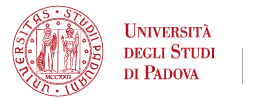
LUISA DALLA VALLE
Title: Professore associato
SSD: BIO/06 - Comparative Anatomy and Citology
Address: VIA U. BASSI, 58/B - PADOVA
Phone: 0498276188
E-mail: luisa.dallavalle@unipd.it
Curriculum
Present position
Associate Professor of Developmental biology and Cytology (BIO/06)
Previous position
Nov 2001 - Nov 2014: Assistant professor (BIO/06, Comparative Anatomy and Cytology) at the Department of Biology, UNIPD.
Jan 2000 – Oct 2001: Technical assistant at the Department of Biology, UNIPD.
Work address: Department of Biology, via U. Bassi 58/B, 35131, Padova
Education and certified qualifications
1986 Master’s degree in Biological sciences (Summa cum laude), UNIPD.
1988 Professional Qualification as Biologist (mark 150/150).
1993 Ph.D. degree in Comparative endocrinology at UNIPD, Italy.
2014 National scientific qualification for Full and Associate Professor - sector 05/B2 (Comparative anatomy and cytology) (from 24/02/14 to 24/02/20).
2020 National scientific qualification for Full Professor - sector 05/B2 (Comparative anatomy and cytology) and sector 05/F1 (Applied biology) (from January 2020 to January 2029).
Research output
N° of publications: 111 papers published in International Peer-reviewed Journals.
SCOPUS citations: 10312, h-index 40 (dated on September 24, 2025).
Due to issues with the family name, the complete bibliography can be found only in Scopus (ID: 57577281500) or ORCID (https://orcid.org/0000-0001-8097-6369).
Research and professional experience
Jan 1985 - Dec 1986: Internship student. Biology Dept., UNIPD, supervision Prof. L. Colombo.
Mar 1987 - Mar 1988: post-graduate stage at the Laboratory of Comparative Endocrinology and at the Laboratory of Genetics, Biology Dept., UNIPD.
Nov 1988 - Oct 1992: four-year Ph.D. course in Comparative Endocrinology, supervision of Prof. L. Colombo, Biology Dept., UNIPD. During the Ph.D., stage at the Laboratory of Prof. F. Labrie, Department of Molecular Endocrinology, Laval University Medical Center, Quebec, Canada.
Jan 1993 - Dec 1994: two-years research fellowship from “Sistema Lagunare Veneziano”, Research n. 3.3, Biology Dept., UNIPD.
Nov 1994 - Dec 1995: research fellowship from the project CEE AIRI CT92-0308: “Development of new methods for the pathogen control in fish”, Biology Dept., UNIPD and Istituto Zooprofilattico delle Venezie.
Oct 1996 - Dec 1997: research fellowship on “Biochemical analysis of extraglandular steroidogenesis in teleost fish”, Ministero delle Politiche Agricole e Forestali, VI Piano triennale, Biology Dept., UNIPD.
Nov 1998 - Jan 2000: post-doctoral fellowship on “Germinal cells steroidogenesis”, Biology Dept., UNIPD.
Teaching activity
2011 - present: Cellular Biology (72 hours, 8 ECTS), Bachelor’s Degree in Biotechnology
2012 - present: Developmental Biology (56 hours, 6 ECTS), Bachelor’s Degree in Biology
Students mentoring activity
2001 to present - Supervisor of 136 students: 14 Students of Master’s degree (single-cycle degree course - 5 years); 95 Students of Bachelor’s degree (3 years); 27 Students of Master’s degree (2 years) - UNIPD, Italy.
Supervisor of 9 and co-supervisor of 6 PhD students.
Peer Review activity for international journals
Section Board Member of International Journal of Molecular Sciences, since 2020.
Reviewer of papers in several international journal, among them: Journal of Endocrinology, Molecular Psychiatry, Autophagy, Scientific reports, BMC Evolutionary Biology, Chemosphere, General and Comparative Endocrinology, Gene, Differentiation, Molecules, Cells, Biomolecules, ETAP, Journal of Pediatric Endocrinology and Metabolism, International Journal of Molecular Sciences.
Research area
A significant part of my research focuses on steroid hormones, particularly glucocorticoids, which play a pivotal role in maintaining the body’s homeostasis. By interacting with their receptors, these hormones regulate essential processes such as stress response, immune system function, metabolism, and bone homeostasis. Investigating the mechanisms by which glucocorticoids and their receptors act allows us to gain deeper insights not only into physiological processes, but also into the molecular basis of a wide range of diseases, including inflammatory, autoimmune, metabolic, and reproductive disorders.
To specifically investigate the role of individual genes, we employ genome editing techniques based on CRISPR/Cas9. This technology enables us to generate cell lines and model organisms in which selected genes are either deleted (knock-out, KO) or precisely modified (knock-in, KI). These models provide a direct means to assess how the presence, absence, or targeted modification of a gene affects biological processes. We are currently applying these approaches to investigate proteins involved in autophagy, neurodegeneration, and sexual differentiation in zebrafish.
Another important aspect of our work concerns the use of zebrafish, a well-established animal model in biomedical research. Using this system, we investigate the activity of bioactive natural compounds, with a particular focus on their anti-inflammatory and antioxidant properties. This strategy not only helps us elucidate the mechanisms of action of these molecules, but also assess their potential applications in pharmacology and nutraceuticals, especially for the prevention and treatment of chronic diseases associated with oxidative stress and inflammation.
Proposals for thesis
Study of the role played by neuronal hemoglobin in the occurence of neurodegenerative diseases: insights from the zebrafish model.
Role of cortisol metabolism in VHL disease: impact on hypoxia regulation mechanisms using the zebrafish model.
Role of the HSD11B2 enzyme in cortisol metabolism: use of the hsd11b2 mutant zebrafish line to understand the effects of PFAS exposure on bone tissue.
Screening of molecules for RNA delivery in zebrafish embryos.
The proposed theses will involve the application of advanced molecular biology techniques, including CRISPR/Cas9, microinjections of mRNA and morpholino oligonucleotides, expression analysis, immunofluorescence, in situ hybridization, together with breeding and reproduction procedures of the zebrafish experimental model.
Last update: 05/12/2025





